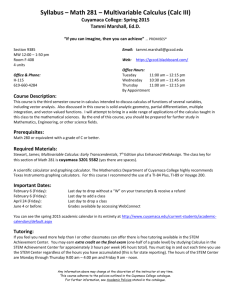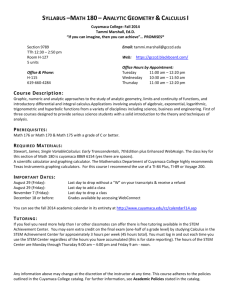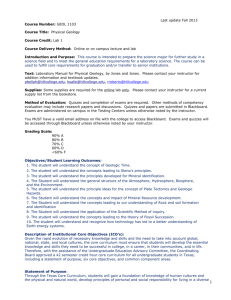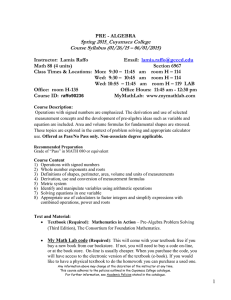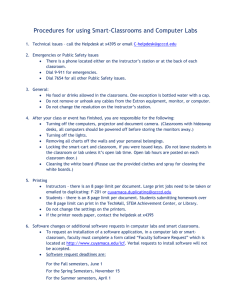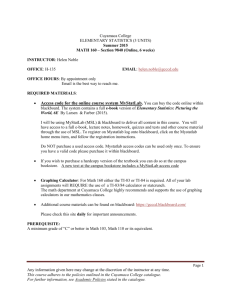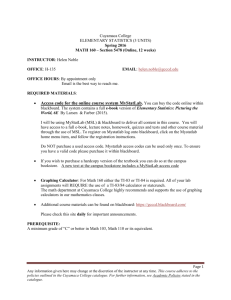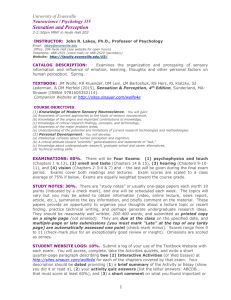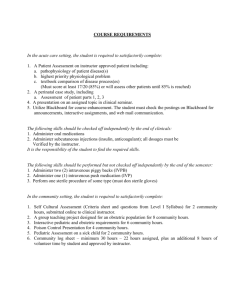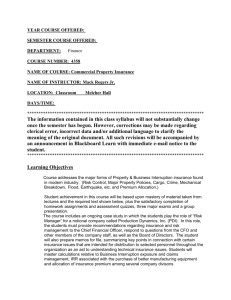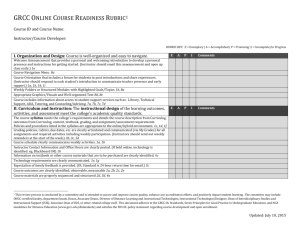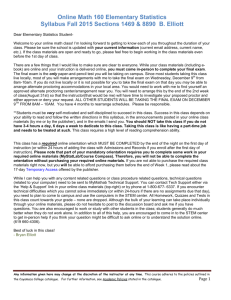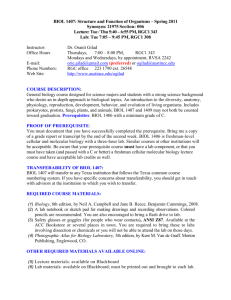Syllabus--Math 103 Intermediate Algebra
advertisement
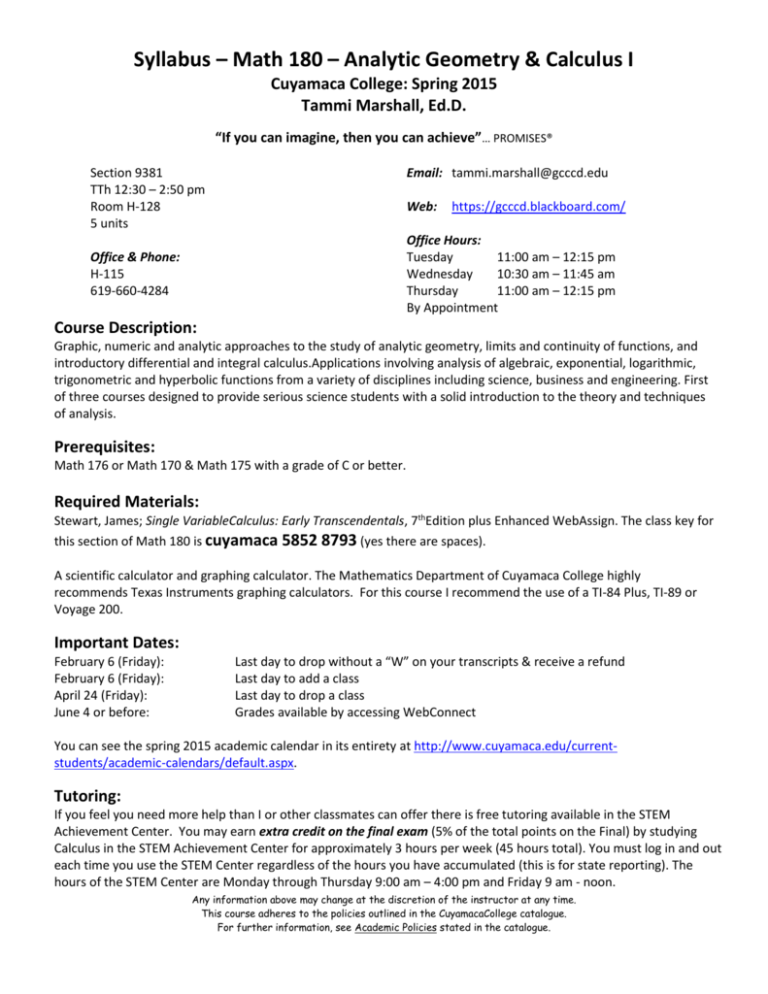
Syllabus – Math 180 – Analytic Geometry & Calculus I Cuyamaca College: Spring 2015 Tammi Marshall, Ed.D. “If you can imagine, then you can achieve”… PROMISES® Section 9381 TTh 12:30 – 2:50 pm Room H-128 5 units Email: tammi.marshall@gcccd.edu Web: https://gcccd.blackboard.com/ Office Hours: Tuesday 11:00 am – 12:15 pm Wednesday 10:30 am – 11:45 am Thursday 11:00 am – 12:15 pm By Appointment Office & Phone: H-115 619-660-4284 Course Description: Graphic, numeric and analytic approaches to the study of analytic geometry, limits and continuity of functions, and introductory differential and integral calculus.Applications involving analysis of algebraic, exponential, logarithmic, trigonometric and hyperbolic functions from a variety of disciplines including science, business and engineering. First of three courses designed to provide serious science students with a solid introduction to the theory and techniques of analysis. Prerequisites: Math 176 or Math 170 & Math 175 with a grade of C or better. Required Materials: Stewart, James; Single VariableCalculus: Early Transcendentals, 7thEdition plus Enhanced WebAssign. The class key for this section of Math 180 is cuyamaca 5852 8793 (yes there are spaces). A scientific calculator and graphing calculator. The Mathematics Department of Cuyamaca College highly recommends Texas Instruments graphing calculators. For this course I recommend the use of a TI-84 Plus, TI-89 or Voyage 200. Important Dates: February 6 (Friday): February 6 (Friday): April 24 (Friday): June 4 or before: Last day to drop without a “W” on your transcripts & receive a refund Last day to add a class Last day to drop a class Grades available by accessing WebConnect You can see the spring 2015 academic calendar in its entirety at http://www.cuyamaca.edu/currentstudents/academic-calendars/default.aspx. Tutoring: If you feel you need more help than I or other classmates can offer there is free tutoring available in the STEM Achievement Center. You may earn extra credit on the final exam (5% of the total points on the Final) by studying Calculus in the STEM Achievement Center for approximately 3 hours per week (45 hours total). You must log in and out each time you use the STEM Center regardless of the hours you have accumulated (this is for state reporting). The hours of the STEM Center are Monday through Thursday 9:00 am – 4:00 pm and Friday 9 am - noon. Any information above may change at the discretion of the instructor at any time. This course adheres to the policies outlined in the CuyamacaCollege catalogue. For further information, see Academic Policies stated in the catalogue. Additional Support: You have a Blackboard account for Math 180 with links to the syllabus and all handouts. In addition, I encourage you to have discussions within Blackboard collaborating with each other. You can access Blackboard at https://gcccd.blackboard.com/. Please visit http://www.cuyamaca.edu/academics/support/help-desk/default.aspx if you are having trouble with using Blackboard. Homework/Worksheets/Quizzes: It is imperative that you are responsible enough to be prepared for the class discussions. This course is taught in what is called a “flipped” or “upside down” format. In other words, you will be reading and watching videos at home while doing worksheets and much of the homework in class. If you have a lap top, iPad or other device, I highly recommend you bring it to class. You can request no more than two homework extensions for the semester (none after the Exam which covers the material). There will be Quizzes periodically in class or on WebAssign as well…there are no make ups for quizzes. Your two lowest scores in this section will be dropped. Group Works: Throughout the semester I will assign Group Works. You are encouraged to work together on the Group Works and turn in one paper for the group. The points for each assignment will be different depending upon the length and complexity of the assignment. Exams: Expect four “two-part” exams. Each exam will consist of a take-home portion and an in-class portion. No makeups, but I will drop your lowest exam. You will be allowed to use a graphing calculator on most of the exams. The exams will consist of problems similar to our class discussions and the homework assignments as well as “concept” problems that require you to “synthesize” the material learned and relate it to the topics covered. After each in-class exam is handed back, you have the opportunity to redo any of the problems in which you missed points. This must be done on separate paper and turned in with your original exam. Based on the correctness of your revisions you can raise your in-class exam score 10%. Final Exam: The comprehensive final exam is scheduled for Tuesday, May 26, 2014 from 12:00 – 2:30 pm. You cannot get a passing score in the class without getting an overall score of at least 60% on the Final Exam even if your overall grade is 70% or above. Evaluation: Exams…………………………………………………………………30% Homework/Worksheets/Quizzes………………………20% Group Works………………………………………………………15% Group Project…………………………………………………….15% Final examination………………………………………………20% A Plus/Minus grading system will be used for final grades. A (Above 90%); B+ (87% - 89.9%); B (80% - 86.9%); C+ (77% - 79.9%); C (70% - 76.9%); D (60% - 69.9%); F (below 60%) Any students seeking an "I" (incomplete) for a grade must file a petition with me citing "unforeseeable, emergency, and justifiable" reasons for this grade. Any information above may change at the discretion of the instructor at any time. This course adheres to the policies outlined in the CuyamacaCollege catalogue. For further information, see Academic Policies stated in the catalogue. Student Learning Outcomes: Upon successful completion of this course, students will be able to: 1. 2. 3. 4. 5. 6. 7. 8. 9. Compute the limit of a function at a real number. Determine if a function is continuous at a real number. Find the derivative of a function as a limit. Find the equation of a tangent line to a function. Compute derivatives including implicit differentiation. Use differentiation to solve applications such as related rate problems and optimization problems. Graph functions using methods of calculus. Evaluate a definite and indefinite integrals. Apply integration to find area. Food Policy: You may have drinks in class as long as it is in a container that can be closed tightly and is not likely to spill if dropped. I encourage you to use your own reusable drink container for class. Generally speaking no food is allowed during class time. You may have food with you to snack on in the classroom during breaks, but I do not want the distraction of food during class. Be aware that NO drinks or food are allowed in any computer lab and upstairs in Science labs. In addition, only water is allowed in the STEM Achievement Center. Class Policies: All cell phones must either be turned off or put on vibrate during class time. They are not allowed on desks or in your pockets during exams. Math is not a spectator’s sport. A student may be dropped for four or more absences but the student is ultimately responsible for officially withdrawing from the course. If absences become a problem, please come and speak with me. If you miss class you must email the instructor to inform her of the absence. If you are caught cheating or plagarizing, you will earn a ‘0’ on that assignment. If it happens a second time, you will earn a ‘0’ on that assignment and I will report the incident to the Student Affairs Office. You are responsible for getting class notes and any schedule changes or other announcements on days missed from the class. Any changes and announcements will be posted on Blackboard. You are expected to be courteous to each other and to the instructor. You will be asked to leave the class for display of behavior the instructor deems as disruptive to the learning environment. You are expected to work actively with your peers, sharing, taking and giving, listening and explaining, questioning and answering. You are responsible for being prepared for participation in class discussions and in group work, and for assisting your peers to come to an understanding of mathematics. Any information above may change at the discretion of the instructor at any time. This course adheres to the policies outlined in the CuyamacaCollege catalogue. For further information, see Academic Policies stated in the catalogue. Math 180; Class Schedule Spring 2015 T. Marshall Week 1 (1/26 – 1/30) — Introduction; Sections 2.1 – 2.2 Week 2 (2/2 – 2/6) — Sections 2.2 – 2.3 Week 3 (2/9 – 2/13) — No Classes 2/13 (President’s Day); Sections 2.4 – 2.5 Week 4 (2/16 – 2/20) — No Classes 2/16 (President’s Day); Sections 2.6 – 2.7 Week 5 (2/23 – 2/27) — Exam 1; Sections 2.8; 3.1 Week 6 (3/2 – 3/6) — Sections 3.2 – 3.4; Project Group Members & Topic Due Week 7 (3/9 – 3/13) — Sections 3.4 – 3.5 Week 8 (3/16 – 3/20) — Exam 2; Section 3.6; 3.11 3/23 – 3/27 — Spring Break/No Classes Week 9 (3/30 – 4/3) — Sections 3.9; 4.1 – 4.2; Project Progress Report, Part 1 Due Week 10 (4/6 – 4/10) — Sections 4.3; 4.5 Week 11 (4/13 – 4/17) — Sections 4.4; 4.7 Week 12 (4/20 – 4/24) — Exam 3; Sections 4.9; 5.1 Week 13 (4/27 –5/1) — Sections 5.2 – 5.4; Project Progress Report, Part 2 Due Week 14 (5/4 – 5/8) — Sections 5.5 Week 15 (5/11 – 5/15) — Exam 4; 6.1 Week 16 (5/18 – 5/22) — Project Presentations; Review Final Exam Tuesday, May 26, 2015 12:00 noon – 2:30 pm Any information above may change at the discretion of the instructor at any time. This course adheres to the policies outlined in the CuyamacaCollege catalogue. For further information, see Academic Policies stated in the catalogue.
